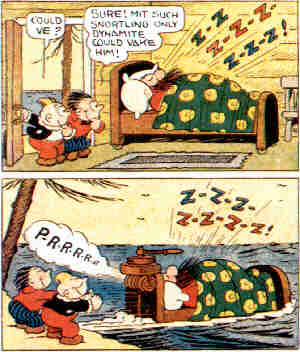| … in America. Unlike the Outcault work, it started out featuring the technique of telling a story in a sequence of panels; and with F.B. Opper's Happy Hooligan leading the way, was also an early user of the word balloon. Whatever the case, The Katzenjammer Kids is not only a long-lasting and, at times, very funny strip — it's also an important one historically.
For many years, it was believed the strip was simply an imitation of an earlier work, Wilhelm Busch's Max und Moritz, which, since 1865, had entertained readers in Germany and later throughout the world. More recent research by comics scholar Alfredo Castelli has unearthed documents showing that in reality, the Hearst organization legitimately licensed Busch's creation — in fact, it appeared under its original name in German-language editions of Hearst's New York Journal.
In any case, Dirks, himself a German-born American, was familiar with the work, and when given the assignment by art director Rudolph Block, had no trouble pitting a pair of incorrigibly mischievous brothers against an older generation poorly equipped to handle their amazingly destructive antics, with "Mama" practically blind to their true nature. This was all done to the tune of a densely German-like patois that was probably a bit too ethnic to be published today. The Sunday page first appeared on December 12, 1897.
The following year, the series had a brief hiatus while Dirks went off to fight in the Spanish-American War. When he returned, he fleshed out the cast by adding The Captain (whose relationship is unclear — Mama Katzenjammer's live-in lover, perhaps?) in 1902 and The Inspector (a truant officer) in 1905. Of the five core characters, only the boys themselves had names — Hans and Fritz — the rest being referred to only by title.
In 1912, Dirks decided to take another leave of absence — he wanted to travel around the world, and devote time to his painting. But this time, the Hearst organization was not willing to suspend the feature, and handed it to Harold H. Knerr, whose credits included Der Fineheimer Twins, a Katzenjammer imitation. When Dirks returned, Hearst refused to give it back, and Dirks went to court. The judge followed a precedent set when The Yellow Kid switched papers in 1896 and Buster Brown in 1906 — Hearst kept The Katzenjammer Kids, but Dirks was allowed to use the same characters elsewhere, provided he used a different title for the strip. In 1914, he started a new strip in the rival Pulitzer papers, which, under the title The Captain & the Kids, ran for more than half a century.
Meanwhile, the original Katzenjammer Kids strip continued, with Knerr remaining on the Sunday page for over a third of a century. During World War I, when all things German were verboten, the name was changed to The Shenanigan Kids, Mike and Aleck rather than Hans and Fritz, and their nationality officially became Dutch. They reverted in 1920. They travelled extensively during the Knerr years, with storylines taking place everywhere from the Arctic tundra to the Amazon jungle. They finally settled on the Squee-Jee Islands, off the coast of equatorial Africa, in 1936. That was also the year their teacher, Miss Twiddle, and her niece, Lena, joined the cast.
Starting in 1917, there was a daily version of the strip, titled The Katzies. It lasted only a few years, however, and Knerr had no hand in writing and drawing it. Knerr did add a topper, Dinglehoofer und His Dog, in 1926. Despite another wave of anti-German sentiment surrounding World War II, this feature lasted until 1953.
Knerr died in 1949, and the strip passed first into the hands of Doc Winner, and later to Joe Musial, who handled it for many years. Gradually, its ethnicity was de-emphasized. Eventually, it was handed over to journeyman cartoonist Hy Eisman, who does it today. Eisman also writes and draws the current Sunday version of Popeye.
The "Katzies" were never a great success outside of comics. There was a stage play in 1903, an animated version during the silent era, a few Big Little Books in the 1930s, appearances in the back pages of King Comics and its companions in the '30s and '40s, and a few comic books of their own, published by Standard and Harvey Comics in the '40s and 50s.
That, and a postage stamp — in 1995, the U.S. Postal Service recognized the strip's classic status by including it, along with Prince Valiant, Bringing Up Father, Dick Tracy and several others, in its "Comic Strip Classics" series of stamps.
Another testament to its classic status is the fact that after more than a century, it is still being syndicated by King Features — making it, by far, America's all-time longest-running comic strip.
— DDM
BACK to Don Markstein's Toonopedia™ Home Page
Today in Toons: Every day's an anniversary!
| |
Purchase Toon-related Merchandise Online
|
